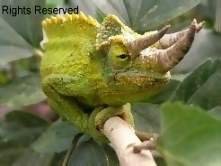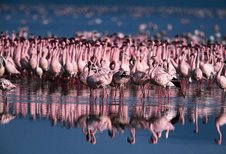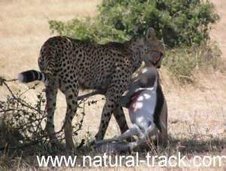On the tropical land widely known as the craddle of mankind, sixteen kilometers south of equator lie a magficent land mark. It raises 5199 metres above see level making it the second highest mountain in Africa and the highest in Kenya. The highest peaks are Batian and Nelion – only mountaneers with technical skills can reach it. Point Lenana is the third highest peak and can be reached by trekkers – and is usually the goal for most people wishing to turf this great mountain locally known as Kirinyaga.
Mount Kenya, a mountain cocktailed with numerous intrinsic worth of significance and an attractive proposal for a Kenya tour. Its native appeal have carried its lure to every generation whether past, present or those that their fate of existence is eagerly awaiting. There are superb views over the surrounding country from point Lenana. The summit is often cloacked in mist from late morning until late afternoon.
Of ultmost importance is the cultural heritage and belief of the 'Agikiyu' also known as Kikuyu who trace their roots from this magnicent dome. The Kikuyu folktale of origin is as interesting as trekking Mt. Kenya itself.
They say "During ancient creation days, a dense cloud stood over the land as Ngai (the divider of the universe) descended to earth and made his dwelling upon the snow-capped peaks of Mount Kenya. Then He (Ngai) beckoned Gikuyu to the consecrated mountain and gave him the land around Kirinyaga (Mt. Kenya) as an inheritance and treasure for Him and his descendants. Then Gikuyu went to an orchard of sacred fig trees. While resting, Gikuyu found a beautiful woman who He gave her the name Mumbi and took her for his wife. They were then hallowed with nine charmingly glance daughters who later grew into very beautiful women. The daughters kept on besseeching saying their parents saying "Oohh that we would have husbands and build our own homes so that the names of our parents would last forever"
For many moons, Gikuyu and Mumbi searched their hearts in their quest to satisfy their daugthers' desires. At last in despair, Gikuyu fell upon his knees. Raising his face to Kirinyaga he called upon his creator, to bless his daughters with husbands and Ngai heard Him and commanded Gikuyu to make a sacrifice under the orchard of the fig tree. Heeding the commandment, Gikuyu sacrificed a lamb and a sheep fowl and lit a fire with nine burning sticks and said " we have come to beseech thee for rain that satsfies our children. Say now that the rain may fall" Suddenly out of the fire came nine young men whose backs were firm and strong like the trunk of the sacred Mugumo (fig) tree and when Gikuyu saw them, he gave thanks and welcomed them to the homesated.
Unanble to resist the beauty of Gikuyu and Mumbi's daughters, they asked for their hand in marriage. Gikuyu blessed the marriages and each daughter built herself a hut and started their families thus the name of Gikuyu and Mumbi prospered. Each daugthers generation came together to form a clan thus the nine Kikuyu clans. From the tribute of Gikuyu and Mumbi and in the honor of Ngai, the Kikuyu's build their houses with doors facing Mountains Kenya. It is also not uncommon to see Kikuyu burrying their dead relatives with head facing Kirinyaga.
Tales of Kikuyu's enterpreneurship are not uncommon in the modern world, their hardwork, determination and industrious innovative investments are inspiring. This is without the fact that the Kikuyu's form the largest ethnic group in Kenya with the widest political and economical representation in Kenya. While on Kenya safari, you will not miss tales of this industrious ethnic group")
Of further startling trait is how Mount Kenya was named. Dr. Edward Krapt was the first white man to see the snow peaks on the equator and by spotting the glaciers of Mt. Kenya from a great distance he was motivated to find out more about the epidode. Curious of such an historic and fulfilling phenomena he asked a Kamba elder of the name of the mountain. Unable to pronounce Kirinyaga, the Kamba elder said Kiinyaa and Krapt translated it as Kenya thus the name upto date.
Mount Kenya is also surrounded by a national park called by the same name. The park, which was inscribed by UNESCO as a World Heritage Site in 1997 and is a Biosphere Reserve, covers 715 km2, and includes the Peaks consisting of all the ground above 3200m with two small salients extending lower down to 2450m along the Sirimon and Naro Moru tracks. Surrounding the park is approximately 2095 km2.
The park has incredible attractions such as; Pristine wilderness, lakes, tarns, glaciers and peaks of great beauty, geological variety, forest, mineral springs, rare and endangered species of animals, High altitude adapted plains game, Unique montane and alpine vegetation with 11 species of endemic plants.
The vegetation varies with altitude and rainfall, and there is a rich alpine and sub-alpine flora making the mountain beautiful and live almost to the peaks. Part of the mountain’s fascination is the variation in flora, including Giant Groundsel and Lobelia, and fauna as the altitude changes. The lower slopes are covered with dry upland forest, the true montaine (mountain) forest begins at 2,000m is mainly cedar and podo. At 2,500m begins a dense belt of bamboo forest which merges into the upperforest of smaller trees, interspersed with glades. In this area the trees are festooned with high altitude lichen.
These forest belts are host to many different animals and plants with at least 11 unique species. Game to view includes: Black and White Colobus and Sykes Monkeys, bushbuck, Rock and rock Hyrax, Greater galago, white tailed, buffalo, elephant and lower down Olive Baboon, waterbuck, Black Rhino, black fronted duikers, leopard, giant forest hog, genet cat, bush pig and hyena. More elusive is the bongo, a rare type of forest antelope. A number of other rarer species can be found here: Suni Antelope, Mt. Kenya Mole Rat, skinks (lizard), Montane Viper and a variety of owls. Occasional sightings have been recorded of albino zebra.
Birds are not abundant in the forest. But you can find Crowned hawk eagle and the Jackson's francolin. Rarely can you find the Abyssinian long-eared owl. Birds seen from the lodge include; Green ibis, African black duck, Ayres' hawk eagle, Rufous-breasted and great sparrow hawks, Scaly francolin, Silvery-cheeked hornbill, Hartlaubs turaco, red headed parrot, bronze-naped pigeon, Mackinder's eagle owl, Rupells robin chat.
There are two species of giant Lobelias; the narrow, featherly-leafed lobelia telekii and the broad-leafed lobelia keniensis which are a favorite of sunbirds for their half hidden blossoms or the thin shelled snails that make their home there. Plants also include crocus-like flower; Romuela keniensis, two terrestrial orchids - a Disa and a Habenaria, and an orange flowered gladiolus,Gladiolus Watsonioides. The high altitude heath at the top (3,000 – 3,5000m) is generally open, dotted with shrubs: African Sage, protea and helichrysum. The peak (above 3,500m) is moorland, with little game other than high altitude zebra and eland, common in the northern moorland.
Join us for trekking Mount Kenya, and enjoy this beauty on earth!
Adventure Travel Crew
kenya safari desk
Natural Track Safaris
Wednesday, February 18, 2009
Subscribe to:
Post Comments (Atom)









2 comments:
This was a post worth reading! Glad I stumbled across it. Another interesting site I came across was this: www.aardvarktravelcentre.co.za .Take some time and check it out.I will definitely visit again soon. Keep the awesome posts flowing.
This was a post worth reading! Glad I stumbled across it. Another interesting site I came across was this: www.journeyintoafrica.co.za . Take some time and check it out. I will definitely visit again soon. Keep the awesome posts flowing.
Post a Comment